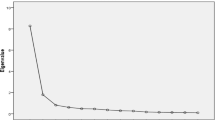Abstract
Aims: To evaluate the validity, reliability, and cultural relevance of the Chinese Mandarin version of Myocardial Infarction Dimensional Assessment Scale (MIDAS) as a disease-specific quality of life measure. Methods: The cultural relevance and content validity of the Chinese Mandarin version of the MIDAS (CM-MIDAS) was evaluated by an expert panel. Measurement performance was tested on 180 randomly selected Chinese MI patents. Thirty participants from the primary group completed the CM-MIDAS for test–retest reliability after 2 weeks. Reliability, validity and discriminatory power of the CM-MIDAS were calculated. Results: Two items were modified as suggested by the expert panel. The overall CM-MIDAS had acceptable internal consistency with Cronbach’s α coefficient 0.93 for the scale and 0.71–0.94 for the seven domains. Test–retest reliability by intraclass correlations was 0.85 for the overall scale and 0.74–0.94 for the seven domains. There was acceptable concurrent validity with significant (p < 0.05) correlations between the CM-MDAS and the Chinese Version of the Short Form 36. The principal components analysis extracted seven factors that explained 67.18% of the variance with high factor loading indicating good construct validity. Conclusion: Empirical data support CM-MIDAS as a valid and reliable disease-specific quality of life measure for Chinese Mandarin speaking patients with myocardial infarction.
Similar content being viewed by others
References
Murray CJ and Lopez AD (1997). Mortality by cause for eight regions of the world: Global burden of disease study. Lancet 349: 1269–1276
Wu XG (2003). Epidemic trends of coronary heart disease in Chinese populations. Chinese J Prevent Control Chronic Non-commun Dis 11(4): 190–191
Health Statistics Information Centre of Ministry of Health, P. R. China. Cummunique of the People’s Republic of China on National Health Care Development from 1997 to 2001. January 13, 2003
Mayou R and Bryant B (1995). Quality of life in cardiovascular disease. Brit Heart J 6: 460–466
Oldridge NB (1997). Outcome assessment in cardiac rehabilitation: Health-related quality of life and economic evaluation. J Cardiopulmonary Rehabil 17(3): 179–194
Treasure T (1999). The measurement of health related quality of life (Editorial). Heart 81: 331–332
Thompson DR and Roebuck A (2001). The measurement of health-related quality of life in patients with coronary heart disease. J Cardiovasc Nurs 16(1): 28–33
Dempster MM and Donnelly M (2000). Measuring the health related quality of life with ischemic heart disease. Brit Heart J 83(6): 641–644
Thompson DR, Jenkinson C, Roebuck A, Lewin RJP, Boyle RM and Chandola T (2002). Development and validation of a short measure of health status for individuals with acute myocardial infarction: The myocardial infarction dimensional assessment scale (MIDAS). Qual Life Res 11(6): 535–543
Liu CJ, Li LX, Ren XH, Li J, Zhang J and Shun D (2001). Feasibility of using Short Form 36 in Chinese population. Acad J West China University Med Sci 32: 39–42
Lam CL, Gandek B, Ren XS and Chan MS (1998). Tests of scaling assumption and construct validity of the Chinese (HK) version of the SF-36 Health Survey. J Clin Epidemiol 51: 1139–1147
Leung KF, Tay M, Cheng SSW and Lin F (1997). Hong Kong Chinese version of World Health Organization Quality of Life measure: Abbreviated Version WHOQOL-BREF (HK). Hong Kong Hospital Authority, Hong Kong
Chie WC, Yang CH, Hsu C and Yang PC (2004). Quality of life of lung cancer patients: Validation of the Taiwan Chinese version of the EORTC QLQ-C30 and QLQ-LC13. Qual Life Res 13: 257–262
Bracken BA and Barona A (1991). State of the art procedures for translating, validating and using psychoeducational tests in cross-cultural assessment. School Psychol Int 12: 119–132
Flaherty JA, Gaviria M, Pathak D, Mitchell T, Wintrob R, Richman JA and Briz S (1998). Developing instruments for cross-cultural psychiatric research. J Nerv Ment Dis 176: 257–263
Polit DF and Hungler BP (1999). Nursing Research: Principles and Methods. J.B. Lippincott, Philadelphia
Streiner DL and Norman GR (1995). Health Measurement Scales: A Practical Guide to Their Development and Use. Oxford University Press, Oxford
(1995). Instrument review criteria [abstract]. Med Outcome Trust Bull 3: I–IV
Jiang XL. The effect of a nurse-led cardiac rehabilitation programme on patients with coronary heart disease in Chengdu, China. Unpublished PhD Thesis, The Hong Kong Polytechnic University, 2005
Dong W, Gai L, Du LS, Yang TS, Zhi G, Li TD. The impact of percutaneous transluminal coronary angioplasty on quality of life of patients with coronary heart disease. Acad J PLA Postgraduate Med School 2001; 22(2): 134–137
Portney LG and Watkins MP (2000). Foundation of Clinical Research: Application to Practice. Prentice-Hall, New Jersey
Tabachnick BG and Fidell LS (1989). Using Multivariate Statistics. Harper & Row, New York
Nunnally JC and Bernstein I (1994). Psychometric Theory. McGraw Hill, New York
Stevens L (1996). Applied Multivariate Statistics for the Social Sciences. Lawrence Erlbaum, Mahwah, NJ
Chang AM, Chau PC and Holroyd E (1999). Translation of questionnaires and issues of equivalence. J Adv Nurs 29: 316–322
Chinese, Mandarin: A Language of China. Retrieved October 10, 2005, from http//www.ethnologue.com
Author information
Authors and Affiliations
Corresponding author
Rights and permissions
About this article
Cite this article
Wang, W., Lopez, V. & Thompson, D.R. A Chinese Mandarin translation and validation of the Myocardial Infarction Dimensional Assessment Scale (MIDAS). Qual Life Res 15, 1243–1249 (2006). https://doi.org/10.1007/s11136-006-0065-1
Accepted:
Published:
Issue Date:
DOI: https://doi.org/10.1007/s11136-006-0065-1




